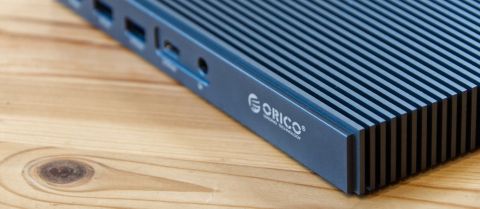TechRadar Verdict
A uniquely styled, engineered and featured Thunderbolt 3 hub. The snags here are the 60W charging limit, the high MSRP, and availability outside the US and China. If this were cheaper and sold more widely, it might have scored higher.
Pros
- +
Gorgeously made
- +
M.2 internal drives
- +
Plenty of ports
Cons
- -
Expensive
- -
Only 60W charging
- -
Limited availability
Why you can trust TechRadar
Almost every technology user has something made by ORICO in their collection, even if it’s a USB cable.
Over the years, this business has produced many adapters and cables that have become must-have hardware for those working in photography, video or just charging multiple phones.
This ORICO product review covers a high-end solution designed to support those that use their laptops alongside monitors, keyboards and other peripherals to create a desktop-like experience.
While it is possible to achieve this with USB, and ORICO makes USB hubs that do exactly that, this design uses Thunderbolt 3.0 as the connection technology.
This isn’t a cheap item, so what makes the ORICO Thunderbolt 3 M.2 Dual-bay Docking Station worthy of the investment?
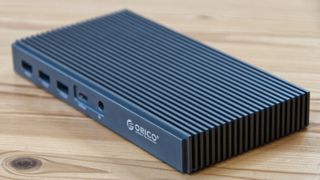
Price, availability and value
The original quoted price for this unit was $399.99, but ORICO decided that might be too much.
Currently, the price on USA Amazon is $359.99 with a 20% store discount that extends to the end of April 2022. As an extra incentive, from 08:00 PDT on April 18th, 2022, through to 23:59 PDT on April 30th 2022, a further 10% off can be had if you follow this link and use the code VV5PIFL8 at the checkout.
All being well, the code should reduce the cost to near $252, making it much more affordable.
That’s excellent news for US customers, but currently, this product isn’t directly available in Europe, only through import from China.
Hopefully, it will be at some point, but when that might be, we’ve no idea.
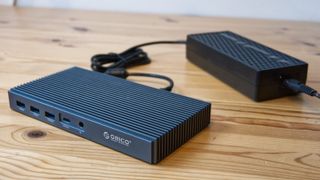
Design
From the point this came out of its box, this Thunderbolt hub is singularly different from almost every other design we’ve seen in the past few years.
The first alternative feature of this design is the heat-dissipating fins that cover both the top and underside. Considering that the enormous PSU, that’s almost as big as the hub, pumps out 120W, that some thermal management is required isn’t a huge surprise.
However, the way this hub is constructed makes the entire outer shell, made from milled aluminium, capable of soaking away heat. This engineering is an effective approach, as we didn’t notice the hub even got warm during our testing.
One of the potential heat-generating locations is on the underside, where a small hatch can be removed to install two M.2 2280 length drives.
Included in the box are two thermal pads that will bridge the air gap between the top of the installed drives and the metal cover. These slots have other issues discussed later, but providing a means to extract heat away into the case structure and a fan mounted below the M.2 drives should avoid thermal throttling.
We’ve only seen included M.2 slots once before in a Glyph hub, but this isn’t the only place this design strays from the typical layout for a Thunderbolt 3 hub.
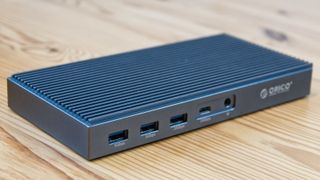
Typically the Thunderbolt link from the laptop inserts at the front of the hub, but for whatever reason, the ORICO design has that port on the back, alongside a DisplayPort outlet, 1Gbit LAN port, a Thunderbolt 3 downlink and the power jack.
There is a 10Mbit USB-C port on the front, but attaching this to a laptop or desktop Thunderbolt port won’t establish a connection to the hub.
On the front are three USB Type-A ports, two being 5Gbps and one 10Gbps and a 3.5mm headphone jack. There is no SD card slot, no power button, and no Kensington security slot.
That last omission will disappoint some IT departments, which won’t wish to deploy such an expensive and potentially pocketable piece of hardware without some insurance that it won’t be nefariously relocated.
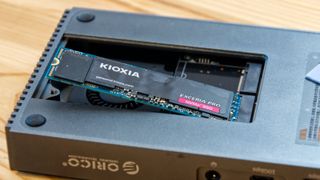
Hardware
Depending on the computer you intend to connect to a Thunderbolt hub, the demands for charging through the device can vary massively.
A typical Ultrabook often needs 60W, whereas mobile workstations can peak at 85W, 87W or more.
Unfortunately, the ORICO Thunderbolt 3 Hub only offers 60W to the connected system and a further 15W to the Thunderbolt downlink.
If you have a laptop that needs more power and want to use it while charging, then the amount of battery power in the system may decline and not increase.
That’s mildly disappointing, but it’s a limitation that several of the most popular designs have.
Another aspect that makers of these devices tend to push under the carpet is the bandwidth available and how it is distributed amongst the ports provided.
Because unless it is a small Thunderbolt hub with very few ports, the total bandwidth demands made by all the ports combined exceeds that available from Thunderbolt.
Those that use the DisplayPort adapter or the Thunderbolt 3 downlink to connect a monitor will immediately reduce the bandwidth from 40Mbit to 20Mbits. And, that 20Mbit is divided between three USB Type-A ports (5Mbps x2 and 10Mbps), a 10Mbit USB-C port, and a 1Gbit LAN port, ignoring the 3.5mm audio jack. Those numbers also don’t include the bandwidth allocated to the M.2 2280 slots, and they are significant bandwidth users.
Obviously, those numbers massively exceed the 20Mbit available or even 40Mbit, if you don’t use connected monitors, so the more things that are connected the less bandwidth each port will have available.
For those connecting mice and keyboards, or even conference cameras to the USB ports, this probably won’t be a huge deal, but it's something to keep in mind for those that see an empty port as merely an unexploited resource.
One area where bandwidth allocation impacts the most is the M.2 slots.
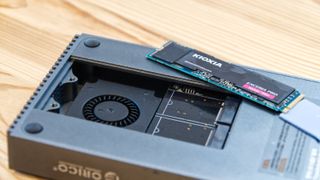
It’s tempting to assume that if there are two M.2 2280 slots inside that these can be loaded up with NVMe drives and get the same experience as mounting them internally. Nothing could be further from the truth.
The first caveat is that while there are two slots, and they can accept both PCIe and SATA M.2 drives, there isn’t enough bandwidth for two PCIe drives.
According to a note on the ORICO website, each drive needs to be of a different protocol.
We tested the unit with a single KIOXIA Exceria Pro 2TB SSD, that’s rated for PCIe Gen4 operations. But when connected to this hardware, it is automatically downgraded to PCIe Gen3 mode.
Where this hardware differs from the M.2 slot seen previously on a Glyph Thunderbolt hub is that this design provides three PCIe Gen3 lanes, not the two the Glyph supports.
That makes an M.2 NVMe drive quicker than in the Glyph dock but not as fast as it would be if mounted inside a computer.
While this choice does make the M.2 slot(s) more useful, using them does make another significant hole in the bandwidth budget of this device.
In use
This hardware is remarkably easy to connect and use, with one small exception.
The way the M.2 slot cover was implemented isn’t a good design.
Our first issue with it is that the fit of the cover plate is to such a high tolerance that even after you remove the two screws, it doesn’t easily come off.
But, when you finally get inside and install drives, it becomes apparent that the external screws as the same ones that hold the drives down using the notched end. Screwing these down when the M.2 drive below can’t be seen is a recipe for an expensive disaster, in this reviewer’s opinion.
The only other usage issue is that, unlike other Thunderbolt 3 Hub makers, ORICO didn’t bother providing any software to quickly disconnect the device. Considering it might have storage connected to the PC, we’d be extra careful about disconnecting a laptop by pulling the Thunderbolt cable out.
For those interested, the performance seen on the M.2 slot using the KIOXIA Exceria Pro 2TB drive was 2777MB/s reads, and 1504Mb/s writes using CrystalDiskMark 8.0.4.
It should be noted that when installed in a native M.2 NVMe PCIe Gen4 slot, the same drive can achieve 7385MB/s reads and 5998MB/s writes.

Competitors
There are plenty of Thunderbolt 4 designs available now with most of the features seen here, and many cost less than this one.
The nearest with similar functionality is the Glyph Thunderbolt 3 NVMe Dock. That can be found for around $249.99 on Amazon. However, the Glyph unit isn’t as elegantly designed or built as the ORICO, and its single M.2 SSD slot performs poorly compared to the interface in this hardware due to the reduced PCIe lane allocation.
If the M.2 SSD capability isn’t a critical requirement, the OWC Thunderbolt Hub (OWCTB4HUB5P) can be found for just $179.00, and Plugable has a Thunderbolt 3 Dock even cheaper at $169.00. Plugable also makes a Thunderbolt 4/USB 4 hub for just $189.00 that can work with laptops that have Thunderbolt or USB 4.0.
In short, even with the discounts currently on offer, cheaper Thunderbolt hubs than the ORICO are widely available.

Final verdict
There are several things about this dock that make it stand out, and most of them are those customers might genuinely want.
All the top of that list, this design has the best M.2 slot in a hub implementation that we’ve seen so far, even if the performance isn’t impressive compared with locally installed drives.
Critically, the selection of ports should satisfy those that want to connect laptops to peripherals and services in the office, what this hardware is ideal for.
While there are some minor distractions, such as the lack of a Kensington security slot and the curious design of the M.2 bay cover, the two biggest issues here are the 60W charging cap and the price.
For many users, the 60W charging limit isn’t a big problem since they’re not using laptops with discrete GPUs or other power-hungry components.
If your system does need 85W or more, you will need to charge it directly using the PSU designed for that machine, and hopefully, the system has a second Thunderbolt port to connect to the dock. Not ideal, but potentially workable, with two Thunderbolt ports.
The price might be more of a challenge, especially if ORICO decides not to continue the current Amazon discounts after April 2022. Availability in Europe might also limit those that can order this hardware until ORICO distributes it more widely.
- We’ve picked out the best laptop docking stations
Mark is an expert on 3D printers, drones and phones. He also covers storage, including SSDs, NAS drives and portable hard drives. He started writing in 1986 and has contributed to MicroMart, PC Format, 3D World, among others.

I'm off to France this summer, and this app could make me très fluent

Intel unveils flurry of new Arc GPUs — however serious graphics users will have to wait for more powerful models, as these focus on a completely different and more lucrative market

We just got another hint that the Samsung Galaxy Watch 7 is almost here
